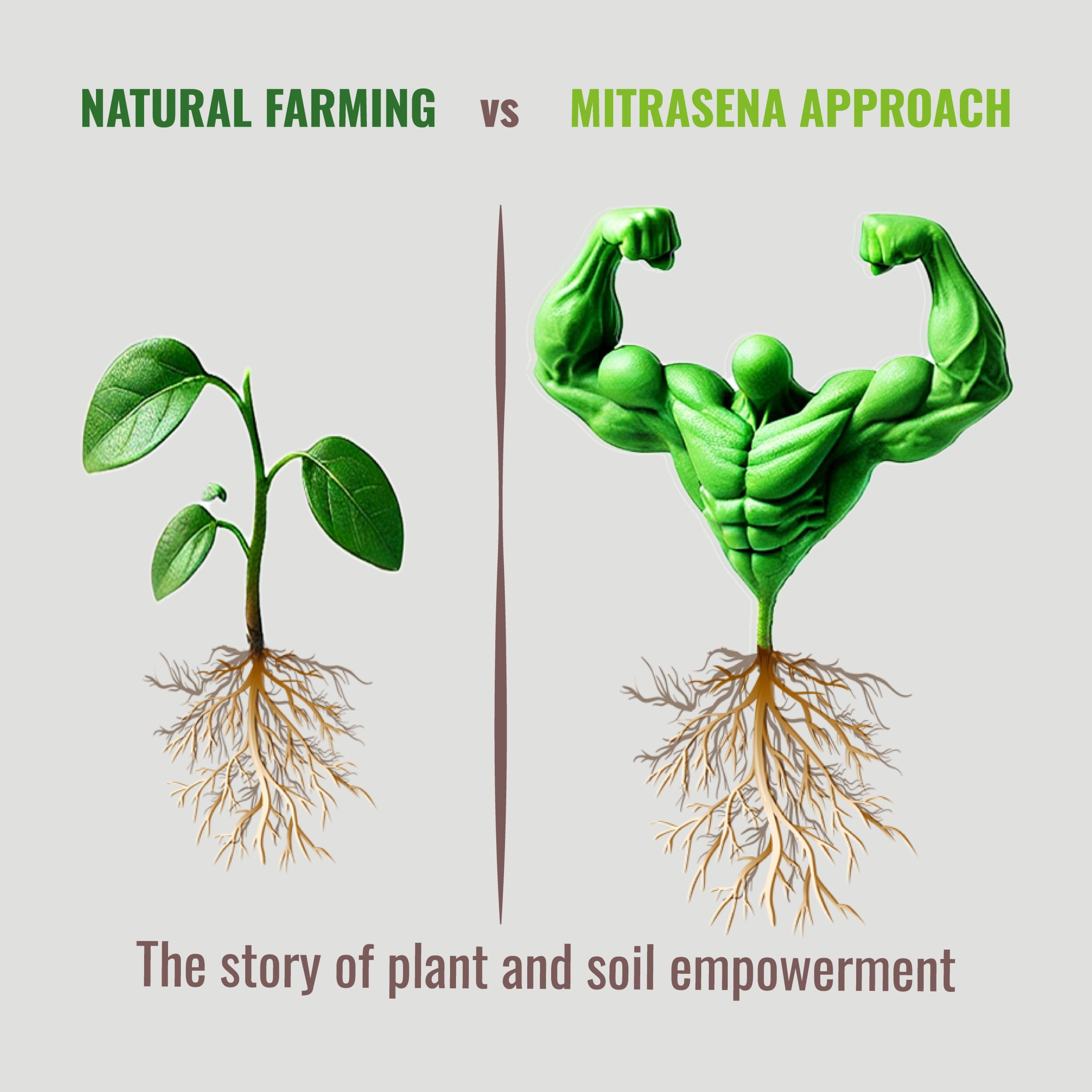
Mitrasena highly appreciates the efforts taken by farmers for natural / organic / sustainable farming. It requires huge passions, a steep learning curve, on-farm efforts and a few years of patience for transition.
Effectively it gets traction when farmers meet some of the following criteria are met:
As is evident, only a small percentage of farmers shall qualify in this list. No wonder that we see slow pace of migration to natural/organic/sustainable farming practices.
Mitrasena offers a gradual transition framework for the large group of farmers engaged in conventional farming. We refer to it as “seamless transition” to “non-toxic farming” with “better productivity & profitability”. It ensures from season one:
This is well reflected in Mitrasena tag line “Fasal Bachaye, Kamai Badhaye. Jahar Hataye, Saral Upay”.
This article touches upon various aspect and offers a comparative understanding of Mitrasena vis-a-vis Natural/Organic/sustainable agriculture.
|
Natural Farming |
Mitrasena Approach |
|
Nutrition Management |
|
|
Considers agriculture as a natural phenomenon not requiring much human intervention.
Total reliance on nutrient supply through organic manure or nutrient recycling from nature. Works on crop rotation & inter-cropping as the solution.
Though, in most cases they realise that it not sufficient and regular farming requires bringing compost, cow-dung etc. from outside to compensate for the loss.
|
Considers agriculture as a part of human engagement with nature for food security. Hence, proposes a midway solution.
Recommends Fertilizers along with Microbials in soil for better availability. Long term gradual reduction in Nitrogen Fertilizer and shifting it to fixing from atmosphere. Considers Silica (Si) as a secondary nutrient along with Ca, Mg, S.
|
|
Pest & Disease Management |
|
|
Believes that healthier plant is less prone to pest & disease attacks. There is no specific approach to improve plant resistance. For secondary control relies on Cow Urine, Neem Oil, Panch Gavya, Dash Parni Ark, Chili, Garlic or other such formula developed for on farm production & usage. Also uses Pheromone Traps & Lures. Uses Bio-Pesticides and Bio-Controls.
Promotes only traditional / indigenous seeds. Do not use hybrid of genetically modified seeds.
Approach is not on killing and hence there is no issue of resistance development.
Lack of pro-active supplements makes plants more vulnerable.
|
Build on “Plant Empowerment” and “Soil Improvement” as the primary defence with strong reliance on Silica, Biopolymer & Microbials along with balanced nutrition. Supported with Neem Oil and Pheromone Traps & Lures. Occasional use of green pesticides or bio-pesticides are recommended.
Silent on seed type and works on all types of seeds – conventional, hybrid or genetically modified.
Approach is not on killing and hence there is no issue of resistance development.
With pro-active supplements, plants are far better prepared to respond to pests & diseases. |
|
Soil Improvement |
|
|
Integral to the core philosophy. All the efforts are focused on soil improvement.
Soil restoration is slower due to lesser intervention. |
Integral to the core philosophy with beneficial microbes and mycorrhiza. Focuses on Improvement in photosynthesis for higher carbon absorption and fixation in soil.
Provides faster soil restoration through intervention.
|
|
Climate Resilience |
|
|
Relies on indigenous varieties which are more climate resilient, though offer lower productivity. Further, improved soil biology & structure makes the crop more resilient to extreme weather events.
|
Strong focus on making plants mitigate climate extremes. Focuses on robust cell structure with silica, deep & wide roots with mycorrhiza, better aeration and soil biology etc.. Improves survival chances in extreme heat, water deficiency, excess rain, excess cold, cloudy days etc.
|
|
Weed Management |
|
|
Normally though manual weed removal. |
Recommends gradual reduction in weedicide usage. Reliance on good composting, on farm composting to reduce weed load.
|
|
Cost & Efforts |
|
|
It is wrongly promoted as zero budget farming. Many inputs are used along with substantial efforts are required. Be it on-farm making of Jeevamrut, or Dashparni Ark or other advised solutions in various practices. It looks low budget because effort, skill and engagement is not quantified, nor is the cost of regular items like Gram Flour, Jaggery, Chilli, Garlic, Neem etc. are taken into consideration.
Real field experience shows substantial “reduction in cost” but at the same time it shows “reduction in productivity”. If the product is sold without premium net earning per Acre goes down. |
A defined protocol with regular supplement. Preventive approach makes it simple to use. Only few products which are simple to use. Easier to plan farm activity & labour management due to defined schedule.
Defined cost as it is proactive in approach. Upfront definition of cost.
Real field experience says that the cost is same or lower than conventional practices. For example, in vegetables, Mitrasena recommends some spray every 5-7 days.
|
|
Productivity & Profitability |
|
|
At least in the first 2-3 years, there is a substantial drop in productivity and hence profitability. |
10-25% higher production due to better crop health. 5-15% higher rates due to superior quality produce Potential for higher premium with residue free produce. 15 – 50% more profit per Acre is estimated in most cases. |
There was this interesting discussion I had with Mr Prateek
The teaser of Self Running Soil Revolution for an investment
The effectiveness of any microbial product depends not just on
Mitrasena (Army of friends) is global brand of Biowall Agrihealth Pvt Ltd. Mitrasena products & protocols enables seamless transition to non-toxic farming by concurrently offering Excellent Protection, Higher Productivity & Profit and, Ease of use.
We are a DIPP recognized Startup working for non-toxic crop protection. We are driven by a highly passionate and professionally competent team.
MitraSena © 2025 | All rights reserved | Innovatively Designed and Built by Social Mukul Media
Have any query about bulk orders? Get in touch with us.